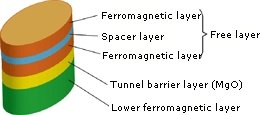Researchers from Japan's AIST institute have developed a new Tunnel-Magnetoresistance (or TMR) element with a low data writing current and high data stability. This kind of TMR is required for high-capacity MRAM. In fact the team says that this TMR can be used to make perpendicular STT-MRAM with densities of over 10GBit.
With existing TMRs, there's a trade-off between data writing current and data stability. Data loss happens if the free-layer's magnetization is reversed because of thermal agitation, and if you make a thicker free-layer it solves the data-loss issues, but you need more current. The new design solved this issue by using a free layer that is made from a nonmagnetic layer between two ferromagnetic layers. The resistance to thermal agitation is improved - it is five times better, while the current is only increased by 80%.
The team used an in-plane magnetization film for the free layer, which can be used to make a 1-Gbit MRAM. They plan to make the current even lower with a perpendicular magnetization film, which will allow for a 10 Gbit MRAM device.

